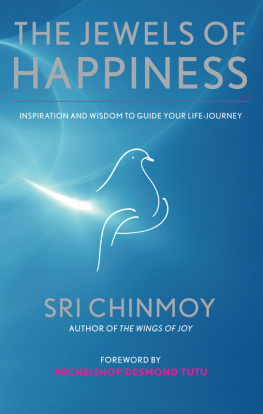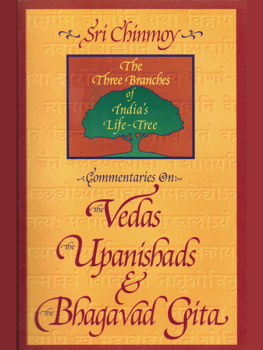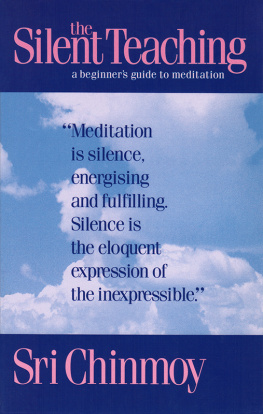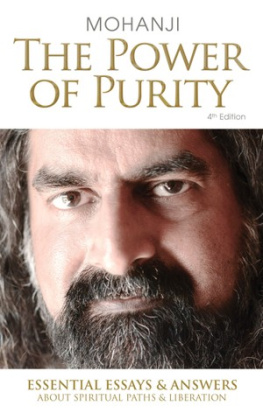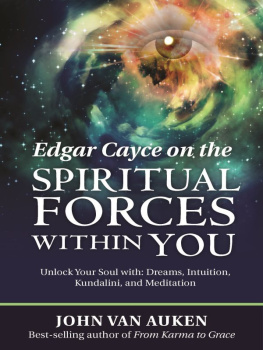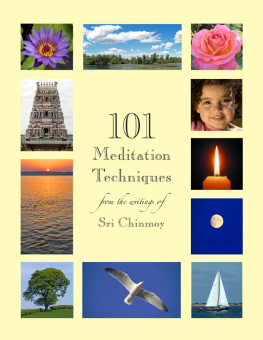BEYOND WITHIN
A Philosophy for the Inner Life
SRI CHINMOY
AUM NEW YORK
Copyright 1974, 1975, 1985, 1987 Sri Chinmoy
Copyright 2014 (eBook) Sri Chinmoy Centre
ISBN: 978-1-938599-56-9
Published by
Aum Publications
8610 Parsons Blvd.
Jamaica, NY 11432
www.srichinmoy.org
iv.
As we indicated earlier, the experience reached in contemplative surrender of oneness with the Divine Reality is not the final stage of the seekers path. There is one further triad, the first stage of which we achieve through our birth into divine individuality. Sri Chinmoy calls this birth Realisation, and the two stages of growth which follow are identified as Revelation and Manifestation.
The process of Realisation, which we have traced in the previous section, is explored in and through the practise of meditation. Were we to leave the seeker here, we would leave ourselves with an image of one withdrawn from the so-called everyday world in a state of complete self-fulfilment. In marking a further movement of the realised seeker through two stages of transformed relation to that every day world, Sri Chinmoy addresses himself to a central question: What is the bearing of meditation upon the needs of humanity? The chapter of the anthology entitled Serving the World contains a number of ways he takes up this question.
At an early point in our discussion we noted that Sri Chinmoy views inner realisation and outer manifestation as going hand in hand. Sri Chinmoy states this not so much as a requirement but as a fact: inner transformation will, perforce, be expressed in outer action. Consequently, when the inner experience is as momentous as Realisation, our sense of ourselves in relation to the world will be equally transformed. For as we now experience the ground of oneness shared by all human beings and conditions of life, we now greet all experience with new capacities of vision and awareness. This ground of oneness permits what Sri Chinmoy calls compassion"our awareness of the Supreme in all beings; and concern"the enactment of that awareness in our interchanges with others. Compassion and concern are qualities central to Sri Chinmoys path.
The dawning of our compassionate identification with others is Revelation". What the illumined mind now experiences, it reveals. What it recognises in itself is revealed to it as latent in others. The seeker becomes a revelation to others of what he or she has realised, while others become a revelation to the seeker of the living truth that resides at the heart, and as the centre, of all being.
Revelation is the showing forth of divine love and joy, a sunniness of our nature which warms and illuminates, and is independent of the boons or privations of circumstances. In the seeker this light is revealed as humility". Humility is no conscious diffidence in a personality, but rather the capacity of the soul to regard its equality with all beings, the spontaneous honouring of the Supreme in ourselves and in others. Sri Chinmoy most often refers to the sense of humility as gratitude". As our experiences in meditation deepen, as the immersion of the seeker in contemplative surrender continues, humility grows, and the seeker feels himself guided by an intuitive voice which comes from within.
Sri Chinmoy calls that voice the Inner Pilot. Our relation to that guiding presence in us transforms our inner contemplative surrender into an outer attentiveness and obedience to what the soul needs for its fulfilment and for the fulfilment of others. Our divine individuality, in Sri Chinmoys sense of the term, involves more than the individuation of infinite consciousness into form; each divine individual has a mission asserts Sri Chinmoy, which begins in realising his or her conscious oneness with the Supreme and is then enacted in the obedience or surrender of the individual to what Sri Chinmoy calls the: Will of the Supreme. Each soul has, in its successive incarnations, different experiences to undergo and perform. Ultimately the divine individual has a single momentous work or duty: to participate, with other spiritually awakened beings, in what Sri Chinmoy calls the transformation of the earth-consciousness. By this he means the process of bringing all humanity to a total and conscious realisation of its true nature. The particular mode of working for that transformation, however, is different from soul to soul. All forms of obedience or surrender to the Will of the Supreme, to the Inner Pilot, constitute the field of our Manifestation.
This obedience, or what Sri Chinmoy may call duty, is not our doing what is expected of us by society, but our surrender to the task of the soul to manifest and to transform. We seek to become what Sri Chinmoy calls perfect instruments of the Will of the Supreme, where perfection depends on the purity of surrender. The more complete and perpetual the surrender to the Supreme, the more freely the soul may bring down, as Sri Chinmoy expresses it, Peace, Light, Delight, Compassion, Love, Concern and Power from the Supreme. In our Realisation human life becomes divine life. In our manifestation the divine life takes a human form.
No separation any longer exists between who we experience ourselves to be when we sit in meditation and who we experience ourselves to be in our daily activity. In surrender we integrate all aspects of our beingbody, vital, mind, and heartinto the souls identity and purpose. In the service of our soul we experience the full poise of our divine humanity. Life is meditation. Meditation is service.
v.
The danger of a formulation such as we have undertaken is twofold. It may oversimplify or schematize experiences which are more fluid and richer than its categories. And it may call too much attention to the structures rather than to the life that animates them. It is best to regard our patterns as provisional and to see through them, in our reading of this anthology, the living relation of elements in harmony. This book can open for us a world, a vision, in which what we had thought to be separate is seen to be fused. We should not assume that any given sentence or entry is dependent upon a highly articulated philosophical system that still eludes us. We do not read the poet needing to know all his work before enjoying a single poem. No more here do the parts hinge upon the whole for either their meaning or their power, but contain the whole implicitly.
The most common grammatical form in Sri Chinmoys writing is what we might recognise as an equation. For example, Consciousness is Reality, or fulfilment is voluntary sacrifice. In such sentences, Sri Chinmoy not only joins but makes equivalent terms which we might think differ in meaning. The mind, encountering such equations, slides by all too easily, finding no grist for its analytical mill. Thus a casual or critical reading of Sri Chinmoy may yield a sense of either abstractness or childlike simplicity. However, the sentence Consciousness is Reality is a perception, not an abstract equation. And just as an image in a poem is a perception to stimulate the readers imagination, here these spiritual images in Sri Chinmoys writings, often bare of embellishments, require for their understanding an act of reading that is, in effect, meditative. If we hold such images in a silent mind, or allow them to resonate in an aspiring heart, the meaning of the words will be released, not by any process of analysis, but by an intuitive glimpsing into the level of awareness which inspired the utterance and on which it is true. Thus we often encounter in Sri Chinmoys writings an apparently philosophical prose style actually operating in a meditative mode. Each sentence may become for the reader a living image of reality, not simply a thought about it. To experience the revelatory power of the image, we must let thought be still. The intention in the writing is never to puzzle, but to elicit our illumination; if we pause long enough in silence to let Sri Chinmoys images unfold in patient reflection, we may find ourselves smiling at their directness and momentarily arrested by the depth revealed.


